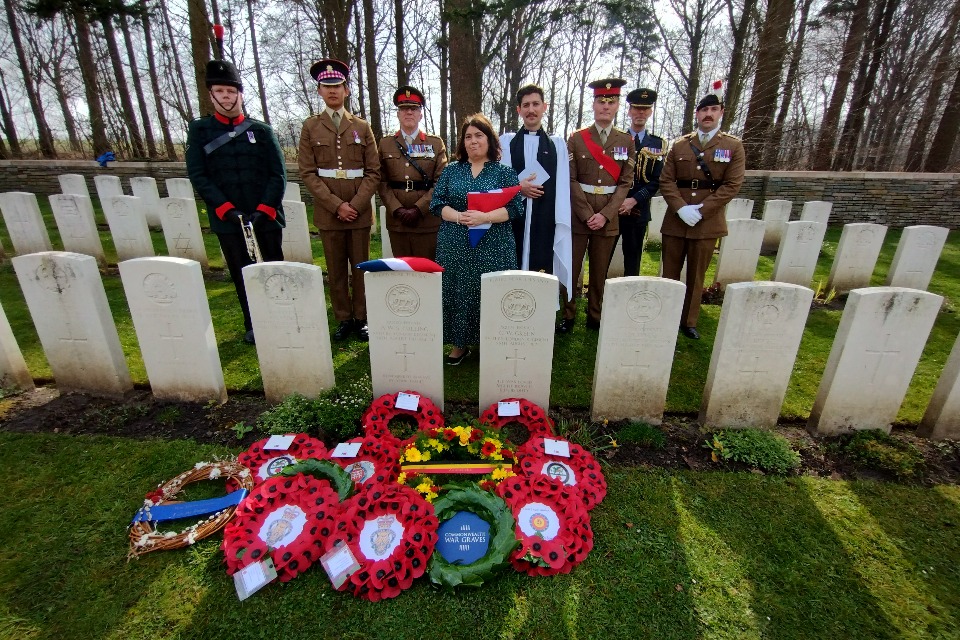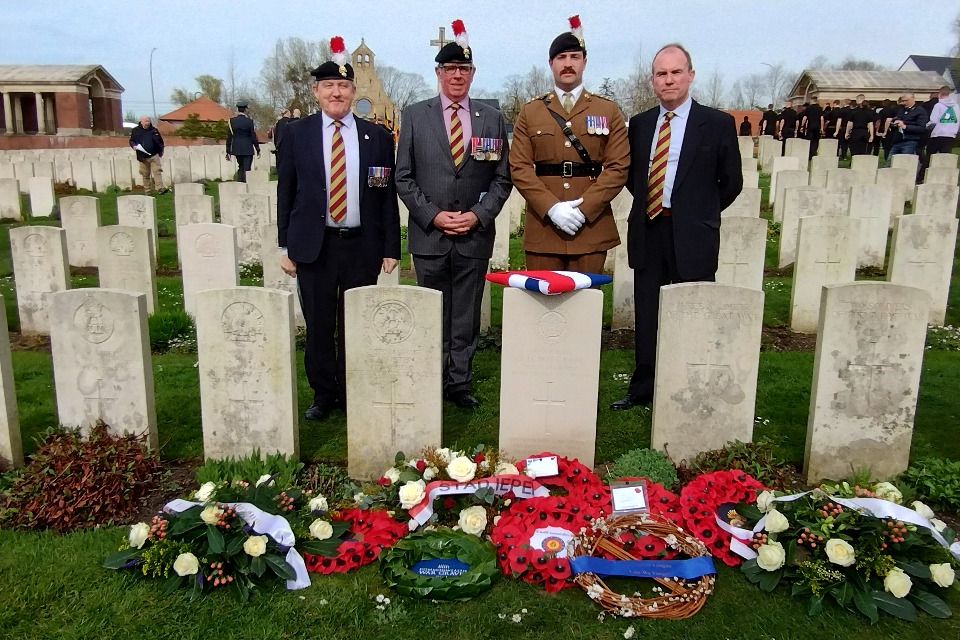Ministry Of Defence

The rededication services for Private (Pte) Albert (Wilfred) Culling and Pte Charles William Green, both of 1/24th Battalion The London Regiment (The Queens), and Serjeant (Sjt) John Harold Bott DCM, of 11th Battalion The Royal Fusiliers (City of London Regiment) were organised by the Ministry of Defence (MOD)s Joint Casualty and Compassionate Centre (JCCC), also known as the MOD War Detectives.
The services were held at the Commonwealth War Graves Commissions (CWGC) Buttes New British Cemetery this morning, and Hooge Crater Cemetery, this afternoon (20 March 24).
Pte Albert (Wilfred) Culling and Pte Charles William Green
On the night of the 24 August 1917, the 1/24th The London Regiment entered the frontline trenches near Westhoek. The diary records show several episodes of shelling throughout the 25 - 26 August, including a 90 minute artillery bombardment beginning at 23:00 hours on the 25 August in which three soldiers were killed and 14 wounded.
The three men who died in the bombardment were Pte Albert Wilfred Saunders Culling, Pte Charles William Green and Pte Albert Henry Hale. They were buried in a shared field grave until March 1920, by which time any marker which might have recorded their names had been lost. As a consequence, they could not all be identified when they were reburied in the CWGCs Buttes New British Cemetery, Polygon Wood.
All three wore regimental insignia identifying them as members of the 24th Battalion The London Regiment, and one had an identity disc which allowed him to be identified as Pte Hale. All three were reburied next to each other at Buttes New British Cemetery, the two unidentified men were buried with the inscription: A Soldier of the Great War 24th Bn London Regiment Known Unto God.
Separately, the names of Pte Culling and Pte Green were engraved on the CWGCs Ypres (Menin Gate) memorial to the missing. More than 100 years later, research has now proven the two previously unidentified burials are those of Pte Culling and Pte Green.

Kelly Salter, great-niece of Pte Green, stands by his headstone with members of the military party. Crown Copyright.
Members of Pte Greens family were at the service, the Culling family were sadly unable to attend.
JCCC Caseworker, Alexia Clark, said:
I am grateful to the researcher who submitted this case. Their work has led us to recognise the final resting place of Pte Culling and Pte Green, to restore their names to them and to allow their families to honour their sacrifice. It has been a privilege for me to have contributed to this case and to have organised the service for the rededication of these graves today.
Sjt John Harold Bott DCM
In the spring of 1917, 11th Battalion The Royal Fusiliers fought in the Battle of Arras before moving to Flanders. On 31 July 1917, the first day of the Third Battle of Ypres, the Battalion went into action again. On 10 August 1917, they took part in an attack on the Westhoek ridge with the aim of taking Inverness Copse, Glencorse Wood and the southern end of the ridge. The two attacking companies followed a barrage at 04:35 hours after which they and the support company reached the Jargon Support Line north of Fitzclarence Farm.
Having come under machine gun fire, the advance halted and their position remained the same until around 06:00 hours, by which stage most of the Officers and Non-Commissioned Officers, including Serjeant Bott, aged 21, had become casualties. The enemy counterattacked from Inverness Copse and the Battalion was pushed back to a strong point on the crest of the Westhoek Ridge. The position was consolidated and held until they were relieved.
After the war Serjeant Botts body was recovered and he was buried as an unknown soldier of The Royal Fusiliers in Hooge Crater Cemetery. It was noted that the Serjeant had received the Distinguished Conduct Medal (DCM). As he was missing, Serjeant Bott was commemorated on the CWGCs Ypres (Menin Gate) Memorial to the Missing. His grave has now been identified after research was submitted to CWGC by two separate researchers. After further research by CWGC, the National Army Museum and JCCC, the findings were confirmed.
JCCC Caseworker, Rosie Barron, said:
Sjt Bott lost his life in one of the most notoriously horrific battles in history, the Third Battle of Ypres. It has been an honour to have played a part in identifying the location of his final resting place and to have been present today as we remember this brave soldiers sacrifice and service.

Captain Jordan Whiteman of the Royal Regiment of Fusiliers stands with members of the regimental association behind the headstone of Sjt Bott.Crown Copyright
Both services were conducted by the Reverend Thomas Sander CF, Chaplain to The Household Cavalry and were attended by representatives from The London Guards, The Princess of Waless Royal Regiment, and The Royal Regiment of Fusiliers.
The Reverend Sander said:
Today we have rededicated the graves of Pte Culling, Pte Green, and Sjt Bott in sure and certain hope that they have found rest among all those who we love but see no longer. We continue to cherish the memory of all those who were lost in the cause of war and pray for peace among all nations and families.
The headstones over both graves were replaced by CWGC who will care for them in perpetuity.
Mel Donnelly, Head of Commemorations at the Commonwealth War Graves Commission said:
For decades, the names of these three brave men have been engraved on our Ypres (Menin Gate) Memorial to the Missing. So, it is a special and poignant moment for everyone today, to be able to mark their final resting places with headstones at Hooge Crater Cemetery and Buttes New British Cemetery respectively. We will care for their graves in
